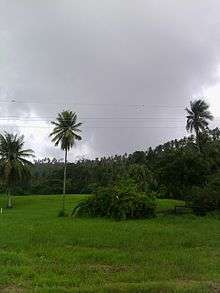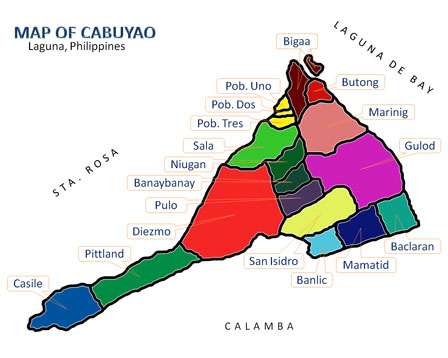Casile, Cabuyao
Barangay Casile is an upland barangay and one of the eighteen (18) urbanized[1] barangays comprising the City of Cabuyao in the province of Laguna, Philippines. It is about twenty three kilometres away from the city proper of Cabuyao and is situated at the western and high elevation portion of the city averaging 352 meters. According to the 2010 Census,[2] it has a population of 2,128 inhabitants (grew from 1,555 in Census 2007[3]). Casile is ranked second to last when it comes to population among the barangays of the town.
Barangay Casile Barangay Kasili (Bahay ni Marcos) | |
|---|---|
 Marcos Twin Mansion in Casile, Cabuyao, Laguna | |
| Nickname(s): Nayon ng Casile, Barrio Casile | |
| Country | |
| Region | Calabarzon (Region IV-A) |
| Province | Laguna |
| City | Cabuyao |
| Incorporated (settlement) | 1571 |
| Government | |
| • Type | Sangguniang Barangay, with Chairman as its head supported by seven (7) Barangay Councilors |
| • Barangay Chairman | Orlando P. de Sagun |
| Area | |
| • Upland Barangay | 1.18 km2 (1.00387 sq mi) |
| • Urban | 2.6 km2 (1.00387 sq mi) |
| Elevation | 352 m (1,155 ft) |
| Population (May 2010) | |
| • Upland Barangay | 2,128 |
| • Density | 1,800/km2 (2,100/sq mi) |
| • Urban | 2,128 |
| • Urban density | 820/km2 (2,100/sq mi) |
| Time zone | UTC+8 (PST) |
| • Summer (DST) | Manila |
| Zip Code | 4025 |
| Area code(s) | 049 |
| Demonym | Casileños |
| Range | Marikina Valley Fault Ridge |
Barangay Casile is popular for its natural heritage and the "Matang Tubig River and Falls", which is now the water source that flows in the whole city. It is also the site of the "Marcos Twin Mansion" which is now owned by the government.
Climate
- Temperature and precipitation
Barangay Casile has a milder climate compared to city proper Cabuyao. It has lower humidity and abundant rainfall. The barangay has an average temperature of 24.3 °C (75.7 °F). With its relatively high elevation, the barangay could be misty at times and is relatively cooler during the months of December, January and February having the characteristics of climate of Tagaytay City due to its elevation and proximity to it.
| Climate data for Barangay Casile | |||||||||||||
|---|---|---|---|---|---|---|---|---|---|---|---|---|---|
| Month | Jan | Feb | Mar | Apr | May | Jun | Jul | Aug | Sep | Oct | Nov | Dec | Year |
| Record high °C (°F) | 30.0 (86.0) |
31.0 (87.8) |
33.0 (91.4) |
34.0 (93.2) |
34.0 (93.2) |
34.0 (93.2) |
32.0 (89.6) |
30.0 (86.0) |
30.0 (86.0) |
30.0 (86.0) |
30.0 (86.0) |
29.0 (84.2) |
34.0 (93.2) |
| Average high °C (°F) | 27.0 (80.6) |
28.0 (82.4) |
30.0 (86.0) |
32.0 (89.6) |
30.0 (86.0) |
29.0 (84.2) |
27.0 (80.6) |
27.0 (80.6) |
27.0 (80.6) |
27.0 (80.6) |
28.0 (82.4) |
27.0 (80.6) |
28.3 (82.9) |
| Daily mean °C (°F) | 22.5 (72.5) |
23.0 (73.4) |
24.5 (76.1) |
26.0 (78.8) |
26.0 (78.8) |
25.5 (77.9) |
24.5 (76.1) |
24.5 (76.1) |
24.5 (76.1) |
24.0 (75.2) |
24.0 (75.2) |
23.0 (73.4) |
24.3 (75.8) |
| Average low °C (°F) | 18.0 (64.4) |
18.0 (64.4) |
19.0 (66.2) |
20.0 (68.0) |
22.0 (71.6) |
22.0 (71.6) |
22.0 (71.6) |
22.0 (71.6) |
22.0 (71.6) |
21.0 (69.8) |
20.0 (68.0) |
19.0 (66.2) |
20.4 (68.8) |
| Record low °C (°F) | 15.0 (59.0) |
16.0 (60.8) |
16.0 (60.8) |
18.0 (64.4) |
20.0 (68.0) |
21.0 (69.8) |
20.0 (68.0) |
21.0 (69.8) |
20.0 (68.0) |
18.0 (64.4) |
18.0 (64.4) |
16.0 (60.8) |
15.0 (59.0) |
| Average precipitation mm (inches) | 10 (0.4) |
10 (0.4) |
12 (0.5) |
27 (1.1) |
94 (3.7) |
153 (6.0) |
206 (8.1) |
190 (7.5) |
179 (7.0) |
120 (4.7) |
54 (2.1) |
39 (1.5) |
1,094 (43) |
| Source: meteoblue.com,[4] | |||||||||||||
Demography
According to 2010 Census,[2] it has a population of 2,128 inhabitants, grew from 1,555 in Census 2007.[3]
West Valley Fault
The West Valley Fault or Marikina Valley Fault System is an active fault, located at the greater of Metro Manila in Marikina.

| No. | Barangay | Rank | Population (2007) | Population (2010) | Population Density (2010) | Annual Growth Rate (Average) |
|---|---|---|---|---|---|---|
| 1 | Baclaran | 9th | 12,683 | 12,192 | 6,985/km2 | |
| 2 | Banay-Banay | 4th | 17,419 | 21,934 | 7.073/km2 | |
| 3 | Banlic | 7th | 9,707 | 12,675 | 5,511/km2 | |
| 4 | Bigaa | 10th | 8,649 | 10,051 | 4,807/km2 | |
| 5 | Butong | 8th | 12,274 | 12,360 | 7,630/km2 | |
| 6 | Casile | 16th | 1,555 | 2,128 | 669/km2 | |
| 7 | Diezmo | 15th | 2,689 | 2,681 | 1,686/km2 | |
| 8 | Gulod | 11th | 10,127 | 9,417 | 2,304/km2 | |
| 9 | Mamatid | 1st | 37,166 | 50,213 | 19,313/km2 | |
| 10 | Marinig | 2nd | 25,619 | 37,169 | 9,494/km2 | |
| 11 | Niugan | 3rd | 21,993 | 26,807 | 7,615/km2 | |
| 12 | Pittland | 18th | 1,627 | 1,740 | 598/km2 | |
| 13 | Pulo | 6th | 13,193 | 15,124 | 5,041/km2 | |
| 14 | Sala | 12th | 7,491 | 8,275 | 5,353/km2 | |
| 15 | San Isidro | 5th | 15,495 | 18,145 | 5,767/km2 | |
| 16 | Barangay I Poblacion | 14th | 2,589 | 2,839 | 12,334/km2 | |
| 17 | Barangay II Poblacion | 17th | 1,947 | 1,840 | 7,886/km2 | |
| 18 | Barangay III Poblacion | 13th | 3,153 | 2,846 | 12,034/km2 | |
| TOTAL | 6th | 205,376 | 248,436 | 5,700/km2 |
See also
- Cabuyao, Laguna
- Laguna, Philippines
References
- Philippine Standard Geographic Code Archived November 14, 2011, at the Wayback Machine
- "Final Results - 2010 Census of Population". census.gov.ph. Archived from the original on 2012-07-07. Retrieved 2012-06-16.
- 2007 Census table for Laguna Archived June 7, 2011, at the Wayback Machine - National Statistics Office
- "Climate: Modelled Casile – Climate graph, Temperature graph, Climate table". meteoblue.com. Retrieved 10 Nov 2019.
